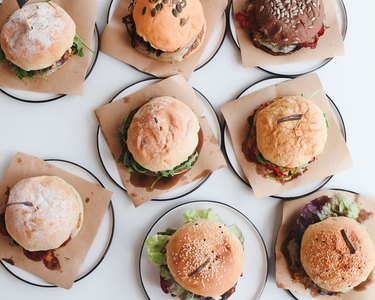
"The perfect burger" might conjure up images of a thick meat patty on a grill, dripping fat into the open flames below. But if you don't have access to a grill, you can still enjoy old-fashioned skillet-cooked burgers.
Some would say that the best way to cook a burger is in a cast iron skillet, although any heavy-bottomed pan will do. You can even use a griddle to cook your burgers.
Video of the Day
Video of the Day
Tip
If you do use a cast iron pan, follow the North Carolina Cooperative Extension's instructions for preheating the skillet and protecting its seasoning — the coating that makes it naturally nonstick.
Cook Burgers on a Stove
For juicy stove-cooked burgers, follow the methods described by Sean Keeley, culinary specialist with Lincoln Land Community College. He recommends setting your skillet on a high-heat burner, seasoning the hamburger patties and then placing them in the skillet. The high heat will help seal in juices and add color.
Although Keeley recommends a hot, dry skillet as the best way to get a good crust on stove-cooked burgers, you may need to add a light brushing or spray of oil to keep the meat from sticking to the pan.
When should you flip the burgers? Keeley suggests waiting until you see blood drops form on the top of the patty. Once that happens, he recommends flipping them and cooking for another 30 seconds. These instructions are for thin patties that are about a quarter-inch thick; thicker burgers will need to cook for longer. Ultimately, you should use a meat thermometer, not a timer or color check, to determine when your burgers are done. More on that in a moment.
There are two big differences between cooking your burgers in a flat skillet versus a more conventional grill. The first is color and markings, because a burger cooked in a skillet will lack the trademark sear marks of a hot grill. The same grill bars that make those marks also reduce your burger patty's contact with its own fat drippings as it cooks.
You can add a removable grill plate to your skillet to create those distinctive sear marks, or some skillets come with the bars of a grill plate built right in, but the fat from your burgers will still pool in the skillet.
Doneness and Food Safety
Food safety is a particular consideration when cooking ground meat. As the USDA Food Safety Inspection Service notes, undercooked ground beef has been linked to numerous outbreaks of E. coli.
One of the most important messages they want you to receive is that, as popular as they may be, color and texture indicators aren't a reliable way of judging a burger's doneness. Some burgers might remain pink even when they're fully cooked, while others may lose that pink color before they've hit a food-safe internal temperature.
That's complicated by the fact that store-bought ground beef is often made up of trimmings from multiple sources in order to reach the specified fat content — which translates to uneven color and texture results in relation to internal temperature.
The solution? Go ahead and use a burger grill time chart as a starting point, but also make the modest investment in a meat thermometer to measure the internal temperature of your burger patties. As the USDA notes, you should insert the food thermometer into the side of the burger, getting the probe point as close to the center of the burger patty as possible.
If your burgers are made of beef, pork, veal or lamb, FoodSafety.gov recommends cooking the meat to a minimum internal temperature of 160 degrees Fahrenheit. If the burgers are made of turkey or chicken, cook them to a minimum temperature of 165 F.
Read more: How to Cook Hamburgers in a Convection Oven
- USDA FSIS: "Color of Cooked Ground Beef as it Relates to Doneness"
- FoodSafety.gov: "Safe Minimum Cooking Temperatures Charts"
- USDA: "USDA's Meat and Poultry Hotline Keeps You 'Food Safe' in the Summer!"
- Lincoln Land Community College: "Burger vs Burger"
- North Carolina Cooperative Extension: "Cooking With a Cast Iron Skillet"